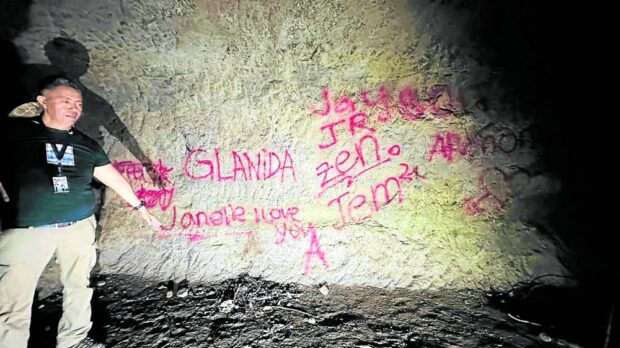
VANDALIZED | Some visitors scrawl their names on the walls of Tunnel 2, desecrating an important spot during World War II in Bamban, Tarlac. Tunnel 2 is part of a network of tunnels that the Japanese carved on the hills of Bamban as the Americans retook the Philippines through fierce battles there in 1945. (Photo courtesy of RHONIE DELA CRUZ)
BAMBAN, Tarlac, Philippines — The Bamban Historical Society (BHS) has called on the local government to stop the vandalism and diggings in two tunnels used as fortresses by the Imperial Japanese Army during World War II.
Rhonie dela Cruz, BHS founding chair, also asked for an inventory of other World War II and local heritage sites, including 20 similar caves that are mostly now on private lands, in letters he sent to Mayor Alice Guo and Vice Mayor Leonardo Anunciacion.
In an April 14 letter, Dela Cruz asked Guo to deploy village watchmen to Tunnels 1 and 2, located near a popular grotto, variously called Bantiti, Asahiyama or Hill 500, in Barangay Lourdes on Bamban Hills, and install signs warning of penalties against vandalism, digging and destruction.
In another letter to Guo and Anunciacion on March 13, BHS recommended the enactment of a local heritage law “for the preservation, protection and development of our historical and heritage sites.”
Gates will be installed at the entrance of the two tunnels to control the crowds and activities there, according to Cherrylyn Pascua, Bamban supervising tourism operation officer, in a phone interview on Wednesday.
She said the preservation of historical sites had been discussed with the National Historical Commission of the Philippines, while a proposed local heritage law is at the research stage.
BHS reported counting 24 sites and four houses during its 2018 inventory of cultural properties in Bamban.
Supply depots
This Tarlac town was drawn to the theater of war due to its closeness to the then Clark Air Base in the border province of Pampanga. Fierce battles between Japanese and American troops occurred before the latter retook Clark in 1945.
Dela Cruz said Tunnels 1 and 2 were carved out of the volcanic grounds by the airfield construction unit of the 4th Air Army as early as 1944 and were used as supply depots for storage.
The 137th Airfield Battalion, also called Hoshino Butai, was in charge of the defense of the Bantiti area.
According to Dela Cruz, the hill was “pockmarked with huge tunnels from the base to the middle slope and fortified with mortars, machine gun nests and aircraft automatic cannons stripped from wrecked aircraft at Bamban Airfield.”
Records showed that the Hoshino Butai “engaged the 3rd Battalion, 160th Infantry, 40th Division, US Army, assisted by local guerrillas from the Bamban Battalion in a vicious combat with the US 5th Air Force P51 Mustang and P38 Lightning, providing air support, strafing and bombing Japanese positions on Jan. 23, 1945.”
Dela Cruz said the two tunnels were among the original tunnels of Hoshino Butai. The rest were lost in the massive aerial, tank, artillery, and tank destroyer fires in the opening salvo of the Battle of Bamban Hills in 1945.
Mt. Pinatubo’s 1991 eruption, as well as erosion after the blasts, buried the other tunnels, he added.
Dela Cruz said another tunnel at Sitio Sampaloc in Barangay San Nicolas, where the Japanese combined naval and air fleet headquarters were located, was preserved by the landowner, the Mallari family.
A tunnel for the communication office in Sitio Panaisan has been on the property of lawyer Louie Balceda. Dela Cruz led the construction of a peace shrine there in 2001. His team covered several holes in the area for safety reasons.
Big batches of Japanese tourists from among the descendants of soldiers visited the Bamban World War II Museum and the tunnels during the summer.

